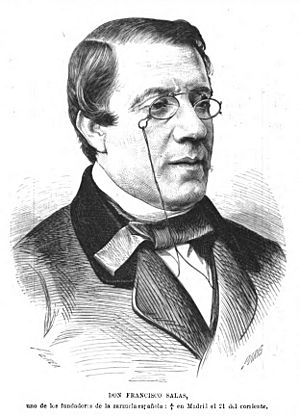Francisco Salas facts for kids
Francisco Salas (born in Albaicín, Province of Granada, on March 12, 1812 – died in Madrid on June 21, 1875) was a famous Spanish opera singer. He had a deep voice, known as a bass-baritone. Salas was a very important person in bringing back the popular Spanish musical theater style called zarzuela.
Contents
Biography
Early Life and Music Training
Francisco Salas was born in Albaicín while the French army was attacking the city. His father passed away the same year he was born. This meant Francisco had to start working hard from a very young age.
A well-known singer named Lorenzo Valencia came to Granada. He was a tenor from Madrid and sang in operas, especially those by Rossini. Valencia became Francisco's first music teacher and helped him a lot.
In 1829, when Francisco was seventeen, they moved to Madrid. He joined the choir at the Teatro de la Cruz theater. There, he continued his studies with other teachers, José Reart and José Valero.
First Performances and Marriage
In October 1831, Francisco Salas got his first big chance as a solo singer. He stepped in for the main bass singer in an opera called I fidanzati, ossia Il contestabile di Chester by Pacini. He did very well and was a success!
After that, he left the choir to sing smaller solo parts. By 1833, his name was even at the top of the posters for the opera Le calife de Bagdad by Boieldieu. Around this time, he met Bárbara Lamadrid, who was also a very important singer in Spain.
Francisco and Bárbara got married and had three children. When they performed together, they sang not only Italian opera songs but also Spanish music. This included traditional Spanish songs called tonadillas, boleros, and dances.
Working with Basilio Basili
Bárbara's sister, Teodora Lamadrid, was an actress. She was married to Basilio Basili, an Italian singer and composer who loved Spanish culture. Francisco Salas worked with Basili on his first Spanish musical comedy. It was called El novio y el concierto. This show mixed Spanish songs with Italian-style music. Even though a famous writer, Manuel Bretón de los Herreros, wrote it, the comedy wasn't very popular.
At this time, Salas was mostly famous for his funny roles in Italian operas. He performed in works by composers like Mercadante, Ricci, Rossini, Bellini, and Donizetti.
Managing a Theater and Promoting Spanish Music
In 1840, Francisco Salas took over the Teatro de la Cruz theater. This allowed him to start promoting Spanish musical works by Basilio Basili. One important show was El contrabandista. Newspapers at the time called it "the first Spanish production of its kind in modern times."
Basili soon composed another work, El ventorrillo de Crespo. However, some people criticized it. They said it was "a rough copy of Italian opera with Spanish songs." In 1842, the theater's company spent two months performing in Granada. The famous singer Pauline Viardot was also there. She met Salas and even sang some duets with him.
Even at just 30 years old, Salas was considered the best Spanish bass-baritone. In 1842, he also became famous as a composer. He published a song called Los toros del puerto, which became incredibly popular. Later, the famous composer Franz Liszt even used its tune in one of his own pieces.
In 1844, Salas and another singer named Ojeda went on a tour to northern Spain, ending in Paris. They hoped to perform at an Italian theater run by Rossini, but it didn't work out. Still, they gave private performances for important people in their homes.
Basili's next opera, El diablo predicador, also faced criticism. People felt it mixed Spanish songs with Italian styles too much. Society really wanted a unique Spanish theater style. The Academia Real de la Música created a group to support these efforts. They held meetings, but not much came from them.
Even the royal family wanted to create Spanish music that could be as good as Italian music. At the wedding celebrations for Queen Isabella II and Prince Francis, Spanish music was featured. Salas performed songs during a play by Hartzenbusch.
The Birth of Zarzuela
In 1846, the Teatro de la Cruz theater closed. The main effort to create Spanish musical theater then moved to the Teatro del Circo. Many songs performed there were chosen because they let Salas show off his amazing singing skills. His performances were a great way to attract audiences.
In 1848, composer Rafael Hernando and writer Mariano Pina Bohígas created Colegialas y soldados. This play was performed at the Teatro del Instituto Español. Many people consider it the first play that truly fit the style of the future zarzuela genre.
Hernando quickly followed up with another successful work, El duende, at the Teatro Variedades. Seeing these successes, Francisco Salas encouraged other writers and composers to create more zarzuelas. He wanted both funny and serious ones.
The main pioneers of this new zarzuela style were composers like Joaquín Gaztambide, Francisco Asenjo Barbieri, and Cristóbal Oudrid. A bit later, Emilio Arrieta also joined them. They worked with talented writers such as Ventura de la Vega, Luis Mariano de Larra, Luis de Olona, and José de la Villa. Thanks to their efforts and Salas's support, zarzuela became a popular and important part of Spanish culture.
See also
 In Spanish: Francisco Salas para niños
In Spanish: Francisco Salas para niños


